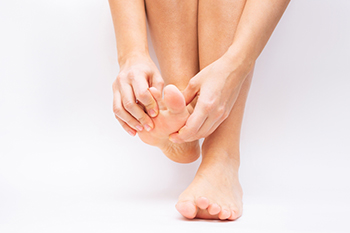
The big toe plays an important role in our ability to walk and remain balanced. The place where the big toe connects to the foot is called the metatarsophalangeal joint (MTP). This joint, like many others in the body, is often the target of osteoarthritis because it gets a lot of wear and tear. Symptoms include pain (especially while active), stiffness, swelling, and a shifting of weight when you walk (change in gait). Occasionally, the big toe pushes toward the other toes, forming a bunion. Stiffness in the joint can result in a difficulty walking, which then can lead to the formation of calluses, corns, and hammertoes. The risk of developing osteoarthritis increases as you age, but other factors such as genetics, obesity, and prior joint injury can contribute to it. As with any progressive disease, osteoarthritis in the big toe can only become worse. Getting treatment from a podiatrist as early as possible is a good idea. X-rays can often detect the extent of the damage to the MTP joint and help the doctor to determine treatment options. Among them are certain prescription medications, changes in footwear, and in severe cases, surgery. For more information on osteoarthritis of the big toe, please consult a podiatrist.
Toe pain can disrupt your daily activities. If you have any concerns, contact one of our podiatrists of Foot & Ankle Associates of Maine. Our doctors can provide the care you need to keep you pain-free and on your feet.
What Causes Toe Pain?
Most severe toe pain is caused due to a sports injury, trauma from dropping something heavy on the toe, or bumping into something rigid. Other problems can develop over time for various reasons.
Toe pain can be caused by one or more ailments. The most common include:
- Trauma
- Sports injury
- Wearing shoes that are too tight
- Arthritis
- Gout
- Corns and calluses
- Hammertoe
- Bunions
- Blisters
- Ingrown toenails
- Sprains
- Fractures (broken bones)
- Dislocations
When to See a Podiatrist
- Severe pain
- Persistent pain that lasts more than a week
- Signs of infection
- Continued swelling
- Pain that prevents walking
Diagnosis
In many cases the cause of toe pain is obvious, but in others, a podiatrist may want to use more advanced methods to determine the problem. These can range from simple visual inspections and sensation tests to X-rays and MRI scans. Prior medical history, family medical history, and any recent physical traumatic events will all be taken into consideration for a proper diagnosis.
Treatment
Treatments for toe pain and injuries vary and may include shoe inserts, padding, taping, medicines, injections, and in some cases, surgery. If you believe that you have broken a toe, please see a podiatrist as soon as possible.
If you have any questions please feel free to contact our office located in Brunswick, ME . We offer the newest diagnostic tools and technology to treat your foot and ankle needs.
